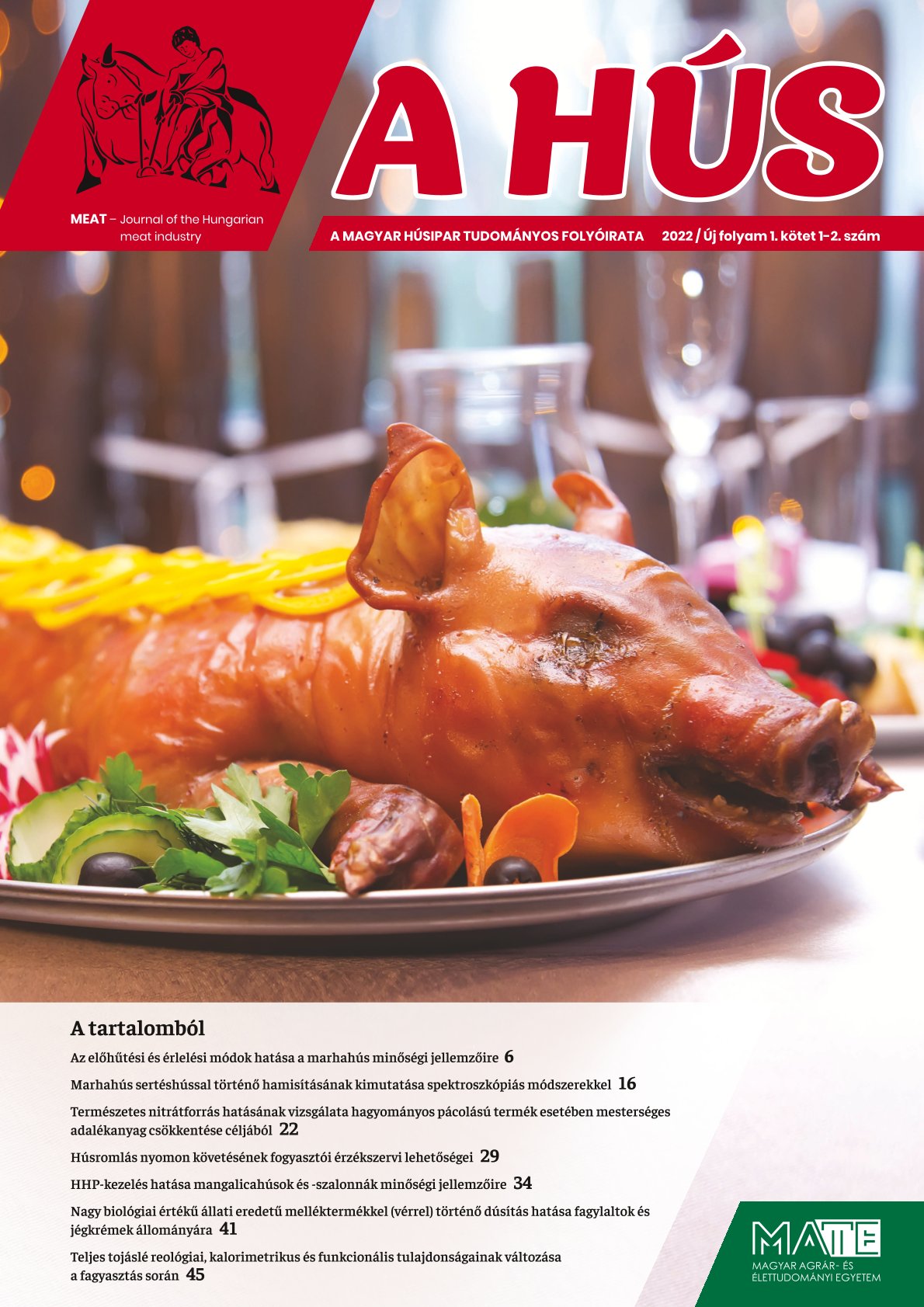Nagy biológiai értékű állati eredetű melléktermékkel (vérrel) történő dúsítás hatása fagylaltok és jégkrémek állományára
DOI:
https://doi.org/10.56616/meat.3413Kulcsszavak:
vashiány okozta vérszegénység megelőzése, funkcionális élelmiszer, állati vér felhasználása fagylaltkészítésnélAbsztrakt
A vashiány okozta vérszegénység globális szinten nagy problémát jelent a gyermekek körében. Ez a probléma megelőzhető, vagy kezelhető olyan, kifejezetten a gyermekek ízlését figyelembe vevő funkcionális élelmiszerekkel, amelyek nagy mennyiségű, jól felszívódó vasat tartalmaznak. A természetben előforduló legjobban felszívódó vasforma az állati vérben található hem-vas, aminek nagy hozzáadott értékű felhasználása a fenntarthatóság szempontjából is igen előnyös. Kutatásunk során teljes vérport, hemoglobinport és az összehasonlítás kedvéért plazmaport adtunk fagylaltmixhez, majd vizsgáltuk a folyékony és keményre fagyasztott állományban okozott változásokat. Több esetben tudtunk szignifikáns változást kimutatni. Ugyanakkor ez a változás nominálisan nem volt jelentős, a folyékony állomány reológiai viselkedését nem befolyásolta, érzékszervi változást nem okozott.
Hivatkozások
BAH, C. S., BEKHIT, A. E. D. A., CARNE, A., MCCONNELL, M. A. (2013): Slaughterhouse blood: an emerging source of bioactive compounds. Comprehensive Reviews. Food Science and Food Safety, 12 (3): 314–331 https://doi.org/10.1111/1541-4337.12013
CSURKA, T., PÁSZTOR-HUSZÁR, K., TÓTH, A., PINTÉR, R., FRIEDRICH, L. F. (2021): Investigation of the effect of trisodium-citrate on blood coagulation by viscometric approach. Agricultural Engineering Sciences, 16 (S2): 19–26. https://doi.org/10.1556/446.2020.20003
DUARTE, R. T., CARVALHO SIMÕES, M. C., SGARBIERI, V. C. (1999): Bovine blood components: fractionation, composition, and nutritive value. Journal of Agricultural and Food Chemistry, 47 (1): 231–236. https://doi.org/10.1021/jf9806255
FLOROS, J. D., NEWSOME, R., FISHER, W., BARBOSA-CÁNOVAS, G. V., CHEN, H., DUNNE, C. P. et al. (2010): Feeding the world today and tomorrow: the importance of food science and technology. Food Science Food Safety, 9: 572–599. https://doi.org/10.1111/j.1541-4337.2010.00127.x
FRØST, M. B., HEYMANN, H., BREDIE, W. L., DIJKSTERHUIS, G. B., MARTENS, M. (2005): Sensory measurement of dynamic flavour intensity in ice cream with different fat levels and flavourings. Food Quality and Preference,16 (4): 305–314. https://doi.org/10.1016/j.foodqual.2004.05.009
HARTEL, R. W., MUSE, M. R., SOFJAN, R. (2003): Effects of structural attributes on hardness and meltingrate of ice cream. In: Goff, H. D., Tharp, B. W. (Eds.), Ice cream II. Special issue 401. Brussels, Int. Dairy Federation, 124–139.
HSIEH, Y. H. P., OFORI, J. A. (2011): Blood-derived products for human consumption. Revelation and Science, 1 (1) 14–21.
MILLER, J. L. (2013): Iron deficiency anemia: a common and curable disease. Cold Spring Harbor perspectives in medicine, 3 (7): a011866 https://doi.org/10.1101/cshperspect.a011866
OCKERMAN, H. W., HANSEN, C. L. (2000): Animal byproduct processing and utilization. Lancaster Technomic Publishing company Inc.
OFORI, J. A., HSIEH, Y. H. P. (2012): The use of blood and derived products as food additives. Food additive, IntechOpen. https://doi.org/10.5772/32374
SORAPUKDEE, S., NARUNATSOPANON, S. (2017): Comparative study on compositions and functional properties of porcine, chicken and duck blood. Korean journal for food science of animal resources, 37 (2): 228–241. https://doi.org/10.5851/kosfa.2017.37.2.228
TOLDRÁ, F., ARISTOY, M. C., MORA, L., REIG, M. (2012): Innovations in value-addition of edible meat by-products. Meat science, 92 (3): 290–296. https://doi.org/10.1016/j.meatsci.2012.04.004
USDA, United States Department of Agriculture, Agricultural Research Service, Nutrient Data Laboratory (2018): USDA National Nutrient Database for Standard Reference, Release 29. https://fdc.nal.usda.gov/
WHO, World Health Organization. (2020): Who guideline on use of ferritin concentrations to assess iron status in individuals and populations.
Letöltések
Megjelent
Folyóirat szám
Rovat
License
Copyright (c) 2022 Csurka Tamás, Hidas Karina Ilona, Pásztorné Huszár Klára

This work is licensed under a Creative Commons Attribution-NonCommercial-NoDerivatives 4.0 International License.



